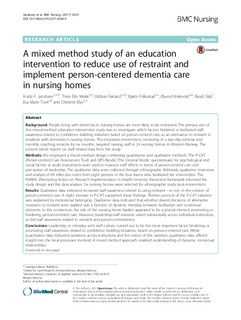| dc.contributor.author | Jacobsen, Frode F. | |
| dc.contributor.author | Mekki, Tone Elin | |
| dc.contributor.author | Førland, Oddvar | |
| dc.contributor.author | Folkestad, Bjarte | |
| dc.contributor.author | Kirkevold, Øyvind | |
| dc.contributor.author | Skår, Randi | |
| dc.contributor.author | Tveit, Eva Marie | |
| dc.contributor.author | Øye, Christine | |
| dc.date.accessioned | 2018-01-02T14:14:16Z | |
| dc.date.available | 2018-01-02T14:14:16Z | |
| dc.date.created | 2017-09-29T11:04:35Z | |
| dc.date.issued | 2017 | |
| dc.identifier.citation | BMC Nursing. 2017, 16 (1). | nb_NO |
| dc.identifier.issn | 1472-6955 | |
| dc.identifier.uri | http://hdl.handle.net/11250/2474117 | |
| dc.description.abstract | Background
People living with dementia in nursing homes are most likely to be restrained. The primary aim of this mixed-method education intervention study was to investigate which factors hindered or facilitated staff awareness related to confidence building initiatives based on person-centred care, as an alternative to restraint in residents with dementia in nursing homes. The education intervention, consisting of a two-day seminar and monthly coaching sessions for six months, targeted nursing staff in 24 nursing homes in Western Norway. The present article reports on staff-related data from the study.
Methods
We employed a mixed-method design combining quantitative and qualitative methods. The P-CAT (Person-centred Care Assessment Tool) and QPS-Nordic (The General Nordic questionnaire for psychological and social factors at work) instruments were used to measure staff effects in terms of person-centred care and perception of leadership. The qualitative data were collected through ethnographic fieldwork, qualitative interviews and analysis of 84 reflection notes from eight persons in the four teams who facilitated the intervention. The PARIHS (Promoting Action on Research Implementation in Health Services) theoretical framework informed the study design and the data analysis. Six nursing homes were selected for ethnographic study post-intervention.
Results
Qualitative data indicated increased staff awareness related to using restraint - or not- in the context of person-centered care. A slight increase in P-CAT supported these findings. Thirteen percent of the P-CAT variation was explained by institutional belonging. Qualitative data indicated that whether shared decisions of alternative measures to restraint were applied was a function of dynamic interplay between facilitation and contextual elements. In this connection, the role of the nursing home leaders appeared to be a pivotal element promoting or hindering person-centered care. However, leadership-staff relations varied substantially across individual institutions, as did staff awareness related to restraint and person-centeredness.
Conclusions
Leadership, in interplay with staff culture, turned out to be the most important factor hindering or promoting staff awareness related to confidence building initiatives, based on person-centered care. While quantitative data indicated variations across institutions and the extent of this variation, qualitative data offered insight into the local processes involved. A mixed method approach enabled understanding of dynamic contextual relationships. | nb_NO |
| dc.language.iso | eng | nb_NO |
| dc.publisher | BioMed Central | nb_NO |
| dc.rights | Navngivelse 4.0 Internasjonal | * |
| dc.rights.uri | http://creativecommons.org/licenses/by/4.0/deed.no | * |
| dc.title | A mixed method study of an education intervention to reduce use of restraint and implement person-centered dementia care in nursing homes | nb_NO |
| dc.type | Journal article | nb_NO |
| dc.type | Peer reviewed | nb_NO |
| dc.description.version | publishedVersion | nb_NO |
| dc.source.pagenumber | 11 | nb_NO |
| dc.source.volume | 16 | nb_NO |
| dc.source.journal | BMC Nursing | nb_NO |
| dc.source.issue | 1 | nb_NO |
| dc.identifier.doi | 10.1186/s12912-017-0244-0 | |
| dc.identifier.cristin | 1500287 | |
| dc.relation.project | Norges forskningsråd: 188928 | nb_NO |
| dc.description.localcode | © The Author(s). 2017 Open Access This article is distributed under the terms of the Creative Commons Attribution 4.0 International License (http://creativecommons.org/licenses/by/4.0/), which permits unrestricted use, distribution, and reproduction in any medium, provided you give appropriate credit to the original author(s) and the source, provide a link to the Creative Commons license, and indicate if changes were made. | nb_NO |
| cristin.unitcode | 194,65,70,0 | |
| cristin.unitname | Institutt for helsevitenskap Gjøvik | |
| cristin.ispublished | true | |
| cristin.fulltext | original | |
| cristin.qualitycode | 1 | |

